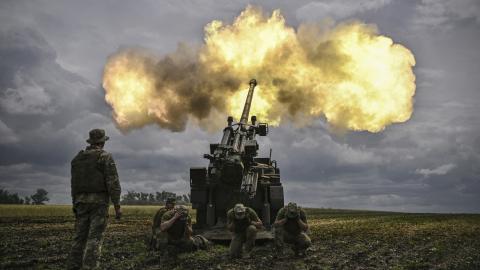Now that the war in Ukraine has entered its second year, the United States needs to address a supply problem that is growing more acute as the war goes on: The United States’ own military does not have enough missiles, rockets, and artillery munitions for modern warfare. As Joint Chiefs Chairman US Army Gen. Mark Milley said recently : “One of the lessons of this war is the very high consumption rates of conventional munitions, and we are reexamining our own stockages and our own plans to make sure that we got it right.” The consequences are potentially alarming: When the Center for Strategic and International Studies recently conducted war games simulating a war over Taiwan, they revealed that the US military would run out of missiles in less than one week.
Washington is searching for an answer. For some, the logical conclusion is to dramatically cut back munitions deliveries and other military aid for Ukraine, starting yesterday. As they see it, China—not Russia—is the United States’ main adversary and biggest threat. Washington should therefore prioritize scarce resources for the Indo-Pacific theater, especially as China’s rapid military buildup increasingly endangers Taiwan. Others counter that Russia is China’s junior partner, and weakening Moscow will make Beijing less willing to tangle with Washington. A Russia diminished and made less threatening by Ukraine will also allow for an even more decisive US pivot to Asia later. Military aid to Ukraine should therefore be prioritized, even at the risk of diminished readiness elsewhere for now.
Whether to direct supplies to Ukraine or the Pacific, however, is the wrong question to ask, because what the United States military can currently field will not secure the balance of power in the Indo-Pacific. The intense use of munitions in the war in Ukraine, the sobering result of the Taiwan war game, and the simple fact that US production of munitions and other equipment is inadequate for much beyond the quick, surgical strikes preferred by military planners all point to one conclusion: The US defense industrial base must be strengthened if these shortfalls are to be met. This will be necessary whether or not any additional US arms go to Ukraine. In fact, arming Ukraine does not need to slow down the response to China. Instead, it can give the United States a running start on revitalizing its defense manufacturing, if the right conclusions about the need to raise defense industrial capacity are drawn now.
The US Defense Department is starting to reach this conclusion. It is ramping up procurement of artillery shells, Javelin and Stinger man-portable missiles, and other surface-to-surface missiles to replace the munitions that have gone to Ukraine, and Lockheed Martin is doubling its Javelin production in response. How much does the aid for Ukraine weaken our deterrence in the Indo-Pacific? Not as much as the Ukraine-versus-Taiwan debate suggests. For the most part, Americans are sending to Ukraine armored vehicles, howitzer shells, and artillery rockets that can only hit stationary targets. These will not be used in the Pacific Ocean. Taiwan has yet to receive the Javelins and Stingers it ordered in 2015, but this is due to a manufacturing backlog that existed long before the war began. Ukraine’s Javelins and Stingers reduce America’s reserve supply, not Taiwan’s orders.
The munitions shortage problem has two distinct, yet interrelated, components. The first is the size of the stockpile. As the war in Ukraine shows, modern militaries expend tremendous amounts of missiles and shells. Consider just one example: The Center for Strategic and International Studies estimates that by April 2022, the United States had already sent 7,000 Javelin anti-tank missiles to Ukraine, roughly one-third of the total US inventory at the time. In December, Raytheon chief executive Greg Hayes noted that “we’ve essentially used up … five years’ worth of Javelin production.” The United States therefore needs to maintain a larger stockpile of munitions for its own defense, as do many of its allies.
The other part of the puzzle is the rate of production. The US defense industrial base is simply not ready to sustain a long-term war effort. In December, Lockheed Martin chief executive James Taiclet said that “the US defense industrial base is scoped for maximum efficiency at peacetime production rates.” The resulting lack of surge capacity in case of war is a profound vulnerability, and unless it is addressed, it will exist whether the war in Ukraine ends tomorrow or in a decade. Simply put, if a war breaks out, the military will have to make do with its existing peacetime stockpile and little ability to replenish its stores.
Washington confronted similar problems in the 1930s. As the situation in Europe and Asia darkened, the United States was only slowly modernizing its military. But when Britain and France ramped up their arms purchases from the United States in 1938, it helped kickstart a revitalization of the US defense industry and even lured new companies into the sector. The Grumman F4F Wildcat, a carrier-based fighter aircraft that was the U.S. Navy’s mainstay during the battles of Midway and Guadalcanal, first entered mass production because of French and British orders. The US Air Force gained air superiority over Western Europe with the aid of the P-51 Mustang fighter, whose manufacturer, North American Aviation, first designed and built that plane for the British. London’s purchases of old US artillery and small arms paid for investments in new artillery production. The mass-produced Liberty ship, a cargo and fuel carrier, was the workhorse that enabled the US military to operate across the Atlantic and Pacific oceans, and it was first ordered by Britain before the United States entered the war. As they armed America’s friends, US manufacturers built the factories their own country would need when it entered the war.
This solution could work again today. Of course, the US military in the 2020s is much stronger than it was in the 1930s, but the defense industrial base is not in great shape. At the end of the Cold War, there were 51 prime defense contractors. Five of them remain today, and most have only survived by focusing on the big-ticket, prestige projects favored by Pentagon planners, and otherwise avoiding risks. As a result, the military only has a single supplier for several key rocket and missile components. One industrial accident could therefore shut down an entire procurement program. For defense manufacturers, building new production lines and factories for ammunition is a major long-term investment, which they will be reluctant to make without evidence that it will pay off. The larger the orders they receive now, the better that investment decision will look.
In munitions, the need is greatest. For example, Ukraine expends about 7,700 artillery shells on an average day. The US Army plans to eventually increase its orders to 90,000 shells per month, that is, supplying about 12 days of Ukraine-level fighting per month. No one knows how long a potential war with China would last, but wars involving industrialized great powers can be long, grinding affairs. Although howitzer shells and some types of rockets would be of little utility in a Pacific war, facilities and workers to produce significantly greater supplies of explosives, propellants, rocket motors, and rocket bodies would be valuable.
The Ukraine aid skeptics are correct to note that time is of the essence. China’s unprecedented peacetime naval expansion is a harbinger of a much bleaker future for Asia, and the United States’ allies and partners in the region, such as Taiwan, need to arm themselves accordingly. Chinese President Xi Jinping has ordered his military to be ready to invade Taiwan by 2027, so the US buildup needs to be ready before then. The longer Washington waits to rebuild, the more likely it will create a situation similar to 1941, when the Japanese military leadership knew it had a short window of time to attack an unprepared United States before the US buildup put Japan’s goals out of reach. Without the capacity to wage war, deterrence to prevent it will fail. Surely it is better to have the factories and workforce to build up stockpiles and raise production in an emergency than to manage a stagnant or declining supply of missiles.
During World War II, building new factories and getting them to full efficiency took several years. US forces should not have to wait even longer for production of today’s much more complicated weapons to be ramped up. From the anti-ship missiles that will be essential in any East Asian conflict to the man-portable launchers and artillery munitions being used in great numbers in Ukraine, the United States and its allies need more of everything to prepare for—and thereby, one hopes, prevent—the worst. By helping the Ukrainians help themselves, Washington can get a running start in solving the problem.





















